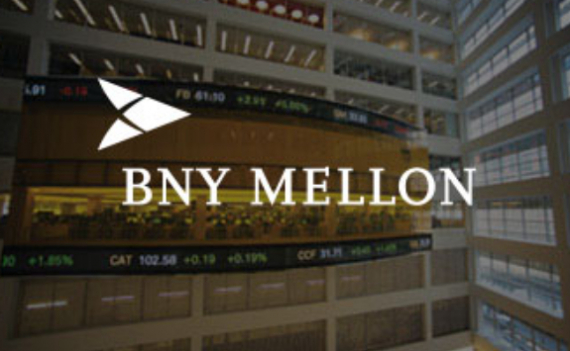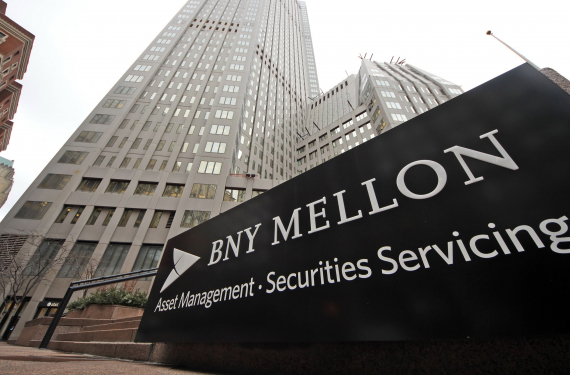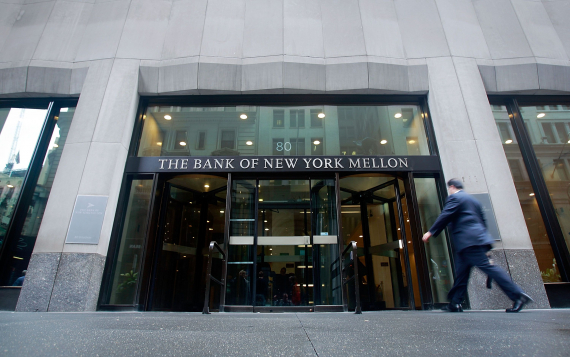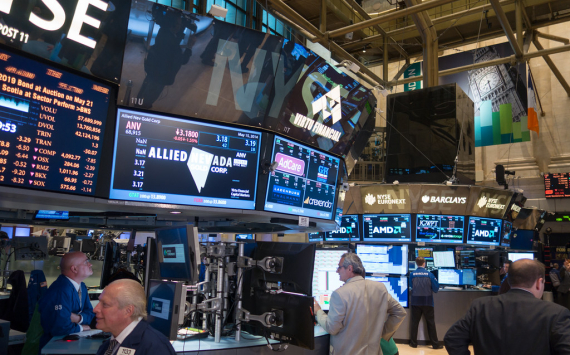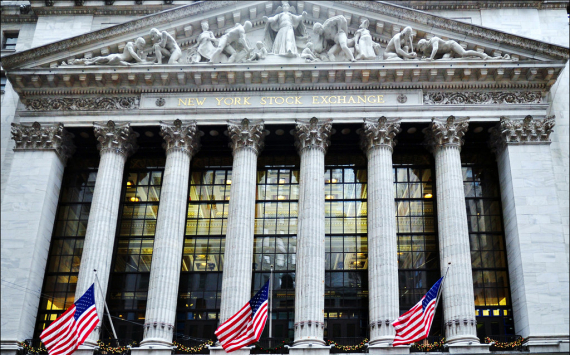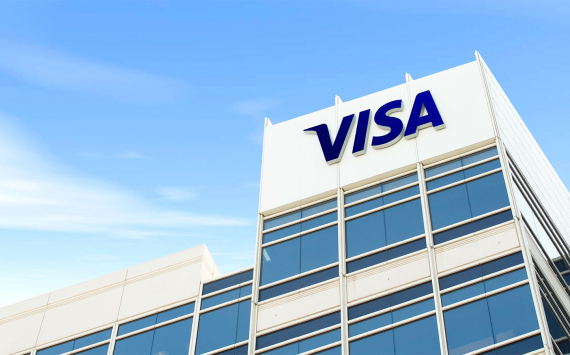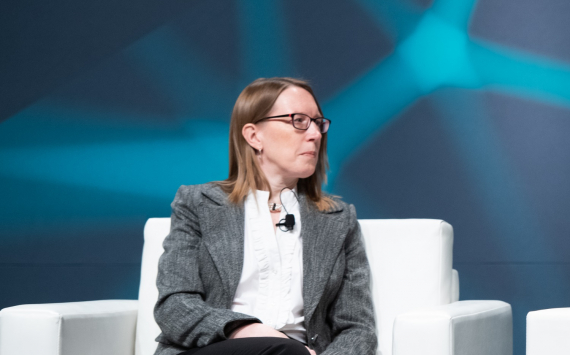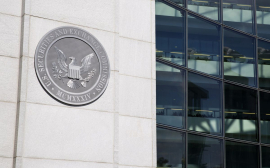Description
The Bank of New York Mellon Corporation, commonly known as BNY Mellon, is an American multinational investment banking services holding company headquartered in New York City. BNY Mellon was formed from the merger of The Bank of New York and the Mellon Financial Corporation in 2007. It is the world's largest custodian bank and asset servicing company, with $1.9 trillion in assets under management and $37.2 trillion in assets under custody as of the second quarter of 2020. BNY Mellon is incorporated in Delaware.
Through its Bank of New York predecessor, it is one of the three oldest banking corporations in the United States, and among the oldest banks in the world, having been established in June 1784 by a group that included American Founding Fathers Alexander Hamilton and Aaron Burr. Mellon had been founded in 1869 by the Mellon family of Pittsburgh, which included Secretary of the Treasury Andrew W. Mellon.
History
Bank of New York
The first bank in the U.S. was the Bank of North America in Philadelphia, which was chartered by the Continental Congress in 1781; Alexander Hamilton, Thomas Jefferson and Benjamin Franklin were among its founding shareholders. In February 1784, The Massachusetts Bank in Boston was chartered.
The shipping industry in New York City chafed under the lack of a bank, and investors envied the 14% dividends that Bank of North America paid, and months of local discussion culminated in a June 1784 meeting at a coffee house on St. George's Square which led to the formation of the Bank of New York company; it operated without a charter for seven years. The initial plan was to capitalize the company with $750,000, a third in cash and the rest in mortgages, but after this was disputed the first offering was to capitalize it with $500,000 in gold or silver. When the bank opened on June 9, 1784, the full $500,000 had not been raised; 723 shares had been sold, held by 192 people. Aaron Burr had three of them, and Hamilton had one and a half shares. The first president was Alexander McDougall and the Cashier was William Seton.
Its first offices were in the old Walton Mansion in New York City. In 1787, it moved to a site on Hanover Square that the New York Cotton Exchange later moved into.
The bank provided the United States government its first loan in 1789. The loan was orchestrated by Hamilton, then Secretary of the Treasury, and it paid the salaries of United States Congress members and President George Washington.
The Bank of New York was the first company to be traded on the New York Stock Exchange when it first opened in 1792. In 1796, the bank moved to a location at the corner of Wall Street and William Street, which would later become 48 Wall Street.
The bank had a monopoly on banking services in the city until the Bank of the Manhattan Company was founded by Aaron Burr in 1799; the Bank of New York and Hamilton vigorously opposed its founding.
During the 1800s, the bank was known for its conservative lending practices that allowed it to weather financial crises. It was involved in the funding of the Morris and Erie canals, and steamboat companies. The bank helped finance both the War of 1812 and the Union Army during the American Civil War. Following the Civil War, the bank loaned money to many major infrastructure projects, including utilities, railroads, and the New York City Subway.
Through the early 1900s, the Bank of New York continued to expand and prosper. In July 1922, the bank merged with the New York Life Insurance and Trust Company. The bank continued to profit and pay dividends throughout the Great Depression, and its total deposits increased during the decade. In 1948, the Bank again merged, this time with the Fifth Avenue Bank, which was followed by a merger in 1966 with the Empire Trust Company. The bank's holding company was created in 1969.
In 1988, the Bank of New York merged with Irving Bank Corporation after a year-long hostile take over bid by Bank of New York. Irving had been headquartered at 1 Wall Street and after the merger, this became the headquarters of the Bank of New York.
From 1993 to 1998, the bank made 33 acquisitions, including acquiring JP Morgan’s Global Custody Business in 1995. Ivy Asset Management was acquired in 2000, and the bank acquired Pershing LLC, the United States' second-largest trade clearinghouse, in 2003.
In 2005, the bank settled a US federal investigation that began in 1996 concerning money laundering related to post-Soviet privatization in Russia. The illegal operation involved two Russian emigres, one of whom was a Vice President of the bank, moving over US$7 billion via hundreds of wires.
In 2006, the Bank of New York traded its retail banking and regional middle-market businesses for J.P. Morgan Chase's corporate trust assets. The deal signaled the bank's exit from retail banking.
Mellon Financial
Mellon Financial was founded as T. Mellon & Sons' Bank in Pittsburgh, Pennsylvania, in 1869 by retired judge Thomas Mellon and his sons Andrew W. Mellon and Richard B. Mellon. The bank invested in and helped found numerous industrial firms in the late 1800s and early 1900s including Alcoa, Westinghouse, Gulf Oil, General Motors and Bethlehem Steel. Both Gulf Oil and Alcoa are, according to the financial media, considered to be T. Mellon & Sons' most successful financial investments.
In 1902, T. Mellon & Sons' name was changed to the Mellon National Bank. The firm merged with the Union Trust Company, a business founded by Andrew Mellon, in 1946. The newly formed organization resulting from the merger was named the Mellon National Bank and Trust Company, and was Pittsburgh's first US$1 billion bank.
The bank formed the first dedicated family office in the United States in 1971. A reorganization in 1972 led to the bank's name changing to Mellon Bank, N.A. and the formation of a holding company, Mellon National Corporation.
Mellon Bank acquired multiple banks and financial institutions in Pennsylvania during the 1980s and 1990s.[31] In 1992, Mellon acquired 54 branch offices of Philadelphia Savings Fund Society, the first savings bank in the United States, founded in 1819.
In 1993, Mellon acquired The Boston Company from American Express and AFCO Credit Corporation from The Continental Corporation. The following year, Mellon merged with the Dreyfus Corporation, bringing its mutual funds under its umbrella. In 1999, Mellon Bank Corporation became Mellon Financial Corporation. Two years later, it exited the retail banking business by selling its assets and retail bank branches to Citizens Financial Group.
Merger
On December 4, 2006, the Bank of New York and Mellon Financial Corporation announced they would merge. The merger created the world's largest securities servicing company and one of the largest asset management firms by combining Mellon’s wealth-management business and the Bank of New York’s asset-servicing and short-term-lending specialties. The companies anticipated saving about $700 million in costs and cutting around 3,900 jobs, mostly by attrition.
The deal was valued at $16.5 billion and under its terms, the Bank of New York's shareholders received 0.9434 shares in the new company for each share of the Bank of New York that they owned, while Mellon Financial shareholders received 1 share in the new company for each Mellon share they owned. The Bank of New York and Mellon Financial entered into mutual stock option agreements for 19.9 percent of the issuer's outstanding common stock. The merger was finalized on July 1, 2007. The company's principal office of business at the One Wall Street office previously held by the Bank of New York. The full name of the company became The Bank of New York Mellon Corp., with the BNY Mellon brand name being used for most lines of business.
Post-merger history
In October 2008, the U.S. Treasury named BNY Mellon the master custodian of the Troubled Asset Relief Program (TARP) bailout fund during the financial crisis of 2007 to 2010. BNY Mellon won the assignment, which included handling accounting and record-keeping for the program, through a bidding process. In November 2008, the company announced that it would lay-off 1,800 employees, or 4 percent of its global workforce, due to the financial crisis. According to the results of a February 2009 stress test conducted by federal regulators, BNY Mellon was one of only three banks that could withstand a worsening economic situation. The company received $3 billion from TARP, which it paid back in full in June 2009, along with US$136 million to buy back warrants from the Treasury in August 2009.
In August 2009, BNY Mellon purchased Insight Investment, a management business for external funds, from Lloyds Banking Group. The company acquired PNC Financial Services' Global Investment Servicing Inc. in July 2010 and Talon Asset Management's wealth management business in 2011.
By 2013, the company's capital had steadily risen from the financial crisis. In the results of the Federal Reserve's Dodd-Frank stress test in 2013, the bank was least affected by hypothetical extreme economic scenarios among banks tested. It was also a top performer on the same test in 2014.
BNY Mellon began a marketing campaign in 2013 to increase awareness of the company that included a new slogan and logo.
In 2013, the bank started building a new IT system called NEXEN. NEXEN uses open source technology and includes components such as an API store, data analytics, and a cloud computing environment.
In May 2014, BNY Mellon sold its 1 Wall Street headquarters, and in 2015, moved into leased space at Brookfield Place. In June 2014, the company combined its global markets, global collateral services and prime services to create the new Markets Group, also known as BNY Markets Mellon. The company expanded its Hong Kong office in October 2014 as part of the company's plans to grow its wealth management business.
Between 2014 and 2016, BNY Mellon opened innovation centers focused on emerging technologies, big data, digital and cloud-based projects, with the first opening in Silicon Valley.
In September 2017, BNY Mellon announced that it agreed to sell CenterSquare Investment Management to its management team and the private equity firm Lovell Minnick Partners. The transaction is subject to standard regulatory approvals and is expected to be completed by the end of 2017.
In January 2018, BNY Mellon announced that it was again moving its headquarters location, less than four years after its prior move. The headquarters location was announced as 240 Greenwich Street, a renaming of the already BNY Mellon-owned 101 Barclay Street office building in Tribeca, New York City. BNY Mellon had owned the office building for over 30 years, with control of the location obtained via 99-year ground lease. The same year, the company purchased the location from the city for $352 million.
Historical data
The following graphs represent the net income and assets and liabilities for the years 2000 to 2016 for the Bank of New York Mellon, the Bank of New York Mellon Corporation's New York state-chartered bank and an FDIC-insured depository institution.
Operations
BNY Mellon operates in 35 countries in the Americas, Europe, the Middle East and Africa (EMEA), and Asia-Pacific. The company employed 51,300 people as of December 2018. In October 2015, the group's American and global headquarters relocated to 225 Liberty Street, as the former 1 Wall Street building was sold in 2014. In July 2018, the company changed its headquarters again, this time to its existing 240 Greenwich Street location in New York (previously addressed 101 Barclay St). The group's EMEA headquarters are located in London and its Asia-Pacific headquarters are located in Hong Kong.
Business
The bank's primary functions are managing and servicing the investments of institutions and high-net-worth individuals. Its two primary businesses are Investment Services and Investment Management, which offer services for each stage of investment, from creation through to trading, holding, management, distribution and restructuring. The bank's clients include 80 percent of Fortune 500 companies. The company also serves 77 percent of the top 100 endowments, 87 percent of the top 1,000 pension and employee benefit funds, 51 percent of the top 200 life and health insurance companies and 50 percent of the top 50 universities.
Investment Services
The bank's Investment Services business represents approximately 72 percent of the company's revenue and it has $31.1 trillion under its custody or administration as of September 2016. The financial services offered by the business include asset servicing, alternative investment services, broker-dealer services, corporate trust services and treasury services. Other offerings include global collateral services, foreign exchange, securities lending, middle and back office outsourcing, and depository receipts.
The company's subsidiary Pershing LLC handles securities services, including execution, settlement, and clearing. It also provides back office support to financial advisors.
In 2014, the company formed a new Markets Group, which offers collateral management, securities finance, foreign exchange and capital markets. The group is now known as BNY Mellon Markets.
Investment Management
BNY Mellon's Investment Management business generates 28 percent of the company's revenue and had US$1.7 trillion (Q4 2016) in assets under management. It operates several asset management boutiques and as of 2014 was the largest multi-boutique investment manager in the world.
BNY Mellon's Wealth Management unit handles the private banking, estate planning, family office services, and investment servicing and management of high-net-worth individuals and families. As of 2014, it ranks 7th among wealth management businesses in the United States. Starting in 2013, the unit began expansion efforts, including opening eight new banking offices, increasing salespeople, bankers, and portfolio managers on staff, and launching an awareness campaign for wealth management services through television ads.
Leadership
Charles W. Scharf was appointed CEO in July 2017 and became Chairman after former CEO and Chairman Gerald Hassell retired at the end of 2017. Hassell had been Chairman and CEO since 2011, after serving as BNY Mellon's president from 2007 to 2012 and as the president of the Bank of New York from 1998 until its merger. Scharf stepped down in 2019 to become the new CEO of Wells Fargo. Thomas "Todd" Gibbons took over as the new CEO in 2020.
Karen Peetz served as president (the bank's first female president) from 2013 to 2016, when she retired; the company did not appoint a new president when she retired. Thomas Gibbons served as CFO between 2008 and 2017, when he also serves as vice chairman. In 2017, Gibbons was replaced as CFO by Michael P. Santomassimo. BNY Mellon's Investment Management business is run by CEO Mitchell Harris, and the company's Investment Services business was led by Brian Shea until his retirement in December 2017.
As of July 2017, the company's board members were Linda Z. Cook, Nicholas M. Donofrio, Joseph J. Echevarria, Edward P. Garden, Jeffrey A. Goldstein, Gerald L. Hassell, John M. Hinshaw, Edmund F. (Ted) Kelly, John A. Luke Jr., Jennifer Morgan, Mark A. Nordenberg, Elizabeth E. Robinson, Charles W. Scharf and Samuel C. Scott III.
Company culture
In 2008, BNY Mellon formed a Board of Directors corporate social responsibility committee to set sustainability goals. The company's corporate social responsibility activities include philanthropy, social finance in the communities the bank is located in, and protecting financial markets globally.
The bank's philanthropic activities include financial donations and volunteerism. The company matches employee volunteer hours and donations with financial contributions through its Community Partnership program. Between 2010 and 2012, the company and its employees donated approximately $100 million to charity.[99] In 2014, the company worked with the Forbes Fund to create a platform that connects nonprofit organizations with private businesses to solve social challenges.
The company received a 100 A rating in 2013, 2014 and 2015 by the CDP, which measures corporate greenhouse gas emissions and disclosures. BNY Mellon was named on the Dow Jones Sustainability North America Index in 2013, 2014 and 2015, and the World Index in 2014, 2015 and 2016. Another one of the company's focuses has been building efficiency. As of 2014, the company has saved $48 million due to building efficiency. Five of its buildings have achieved Leadership in Energy and Environmental Design (LEED-EB) certification and 23 have interiors that are LEED certified.
The company has business resource groups for employees that are focused on diversity and inclusion. In 2009, Karen Peetz co-founded the BNY Mellon Women’s Initiative Network (WIN), a resource group for female employees' professional development. As of 2013, WIN had 50 chapters. Other groups include PRISM for LGBT employees, IMPACT, which serves multicultural employees and HEART for employees with disabilities. The bank has services for returning military, including a tool to help veterans align military skills and training with jobs at the company. In 2014, it was recognized for its diversity practices by the National Business Inclusion Consortium, which named it Financial Services Diversity Corporation of the Year.
In 2009, the company began an innovation program for employees to suggest ideas for large-scale projects and company improvement. Ideas from the initial pilot program generated approximately $165 million in pretax profit. The program results in an annual contest called "ACE" in which teams pitch their ideas.
Controversies and legal issues
Foreign currency exchange issues
In October 2011, the U.S. Justice Department and New York's attorney general filed civil lawsuits against the Bank of New York, alleging foreign currency fraud. The suits held that the bank deceived pension-fund clients by manipulating the prices assigned to them for foreign currency transactions. Allegedly, the bank selected the day's lowest rates for currency sales and highest rates for purchases, appropriating the difference as corporate profit. The scheme was said to have generated $2 billion for the bank, at the expense of millions of Americans' retirement funds, and to have transpired over more than a decade. Purportedly, the bank would offer secret pricing deals to clients who raised concerns, in order to avoid discovery. Bank of New York defended itself vigorously, maintaining the fraud accusations were "flat out wrong" and warning that as the bank employed 8,700 employees in New York, any damage to the bank would have negative repercussions for the state of New York.
Finally, in March 2015, the company admitted to facts concerning the misrepresentation of foreign exchange pricing and execution. BNY Mellon's alleged misconduct in this area includes representing pricing as best rates to its clients, when in fact they were providing clients with bad prices while retaining larger margins. In addition to letting go key executives, the company agreed to pay a total of US$714 million to settle related lawsuits.
In May 2015, BNY Mellon agreed to pay $180 million to settle a foreign exchange-related lawsuit.
In May 2016, multiple plaintiffs filed suit against the bank, alleging that the company had breached its fiduciary duty to ERISA plans that held American Depositary Receipts by overcharging retirement plans that invested in foreign securities. In March 2017, the presiding judge declined to dismiss the suit. In December 2017, another lawsuit alleged that BNY Mellon manipulated foreign exchange rates was filed by Sheet Metal Workers’ National Pension Fund. BNY Mellon agreed to pay $12.5 million to settle the 2016 lawsuit in December 2018.
Personal data breach
In February 2008, BNY Mellon suffered a security breach resulting in the loss of personal information when backup tapes containing the personal records of 4.5 million individuals went missing. Social security numbers and bank account information were included in the records. The breach was not reported to the authorities until May 2008, and letters were sent to those affects on May 22, 2008.
In August 2008, the number of affected individuals was raised to 12.5 million, 8 million more than originally thought.
IT system outages
On Saturday, August 22, 2015, BNY Mellon's SunGard accounting system broke down during a software change. This led to the bank being unable to calculate net asset value (NAV) for 1,200 mutual funds via automated computer system. Between the breakdown and the eventual fix, the bank calculated the values using alternative means, such as manual operation staff. By Wednesday, August 26, the system was still not fully operational. The system was finally operational to regular capacity the following week. As a result of a Massachusetts Securities Division investigation into the company's failure and lack of a backup plan, the company paid $3 million.
In December 2016, another major technology issue caused BNY Mellon to be unable to process payments related to the SWIFT network. As of the time of the issue, the bank processed about 160,000 global payments daily totally an average of $1.6 trillion. The company was unable to process payments for a 19 hours, which led to a backlog of payments and an extension of Fedwire payment services.
Privately owned public space agreement violation
According to a New York City Comptroller audit in April 2017, BNY Mellon was in violation of a privately owned public space (POPS) agreement for at least 15 years. In constructing the 101 Barclay Street building in Lower Manhattan, BNY Mellon had received a permit allowing modification of height and setback regulations in exchange for providing a lobby accessible to the general public 24 hours a day. Auditors and members of the public had been unable to access or assess the lobby for many years, and were actively prevented from doing so by BNY Mellon security.
In September 2018, the company began to permit public access to a portion of the lobby. However, BNY Mellon remains in violation of its agreement, as the lobby must be accessible to the public 24 hours a day.
Employment legal issues
BNY Mellon settled foreign bribery charges with the U.S. Securities and Exchange Commission (SEC) in August 2015 regarding its practice of providing internships to relatives of officials at a Middle Eastern investment fund. The U.S. SEC found the firm in violation of the Foreign Corrupt Practices Act. The case was settled for $14.8 million.
In March 2019, BNY Mellon staff considered legal options after the company banned employees from working from home. In particular, staff cited concerns regarding the impact on childcare, mental health, and diversity. The company reverted the ban as a result of employee outcry.
Other legal issues
In September 2009, BNY Mellon settled a lawsuit that had been filed against the Bank of New York by the Russian government in May 2007 for money laundering; the original suit claimed $22.5 billion in damages and was settled for $14 million.
In 2011, South Carolina sued BNY Mellon for allegedly failing to adhere to the investment guidelines relating to the state’s pension fund. The company settled with the state in June 2013 for $34 million.
In July 2012, BNY Mellon settled a class action lawsuit relating to the collapse of Sigma Finance Corp. The suit alleged that the bank invested and lost cash collateral in medium-term notes. The company settled the lawsuit for $280 million.
In December 2018, BNY Mellon agreed to pay nearly $54 million to settle charges of improper handling of "pre-released" American depositary receipts (ADRs) under investigation of the U.S. Securities and Exchange Commission (SEC). BNY Mellon did not admit or deny the investigation findings but agreed to pay disgorgement of more than $29.3 million, $4.2 million in prejudgment interest and a penalty of $20.5 million.
Recognition and rankings
As of 2015, BNY Mellon was the world's largest custody bank, the sixth-largest investment management firm in the world, and the seventh-largest wealth management firm in the United States. In 2018, BNY Mellon ranked 175 on the Fortune 500 and 250 on the Financial Times Global 500. It was named one of world's 50 Safest Banks by Global Finance in 2013 and 2014, and one of the 20 Most Valuable Banking Brands in 2014 by The Banker.
The bank says it is the longest running bank in the United States, a distinction sometimes disputed by its rivals and some historians. The Bank of North America was chartered in 1781, and was absorbed by a series of other entities until it was acquired by Wells Fargo. Similarly, The Massachusetts Bank went through a series of acquisitions and ended up as part of Bank of America. The Bank of New York remained independent, absorbing other companies, until its merger with Mellon. BNY Mellon is at least the third-oldest bank in the US.
Sponsorships
Since 2012, BNY Mellon has expanded its number of sponsorships. It is the title sponsor of the Oxford and Cambridge Boat Race in London, which had been called the BNY Mellon Boat race from 2012 to 2015. The company also sponsors the Head of the Charles Regatta in Boston. In 2013, the company became a 10-year sponsor of the San Francisco 49ers and a founding partner of Levi's Stadium. The company is a regular sponsor of the Royal Academy of Arts in London.





